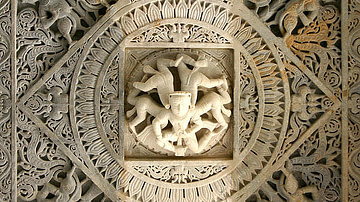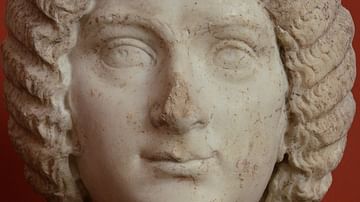Search Definitions
Browse Content (p. 109)

Definition
René Descartes
René Descartes (1596-1650) was a French mathematician, natural scientist, and philosopher, best known by the phrase 'Cogito ergo sum' ('I think therefore I am'). He published works on optics, coordinate geometry, physiology, and cosmology...

Definition
Jainism
Jainism is one of the oldest religions in the world. The name comes from jiva (soul or life force but, capitalized, is also given as Spiritual Conqueror) as it maintains that all living things possess an immortal soul which has always and...

Definition
Lorenzo Ghiberti
Lorenzo Ghiberti (1378-1455 CE) was an Italian Renaissance sculptor and goldsmith whose most famous work is the gilded bronze doors of the Baptistery of Florence's cathedral. These doors, which took 27 years to complete, were so impressive...

Definition
Julia Domna
Julia Domna (160-217 CE) was a Syrian-born Roman empress during the reign of her husband, Roman emperor Septimius Severus (r. April 193 - February 211 CE). She was also the mother of the emperors Geta (r. 209-211 CE) and Caracalla (r. 198-217...

Definition
Pietro Perugino
Pietro Perugino (c. 1450-1523), real name Pietro di Cristoforo Vannucci, was an Italian Renaissance artist who created frescoes for the Vatican's Sistine Chapel and was in demand across Italy to decorate church interiors and produce portraits...

Definition
Titian
Titian (c. 1487-1576 CE), real name Tiziano Vecelli (or Vecellio), was an Italian Renaissance painter who during his lifetime was considered the finest of the Venice school of artists. In a long career working for dukes, kings, and popes...

Definition
Fatimah bint Muhammad
Fatimah (born between 605 and 615 CE, died sometime in 632 CE; date of death is disputed) was the youngest daughter of the Islamic Prophet Muhammad (l. 570-632 CE) and his first wife Khadija (l. 555-619 CE). Taking up after her father, Fatimah...

Definition
Andrea Mantegna
Andrea Mantegna (c. 1431-1506 CE) was an Italian Renaissance artist most famous for his use of foreshortening and other perspective techniques in engravings, paintings, and frescoes. Another common feature of Mantegna's work is his frequent...

Definition
Giotto
Giotto di Bondone (b. 1267 or 1277 - d. 1337 CE), usually referred to as simply Giotto, was an Italian painter and architect whose work was hugely influential in the history of Western art. Giotto is most famous today for the cycle of frescoes...

Definition
Sarpedon
Sarpedon is a figure from ancient Greek mythology, a Lycian prince who was one of the principal heroes during the Trojan War and fought on the side of Troy. According to Homer's Iliad, he was the son of Zeus by Laodameia and the cousin of...